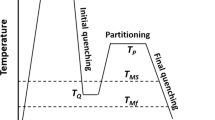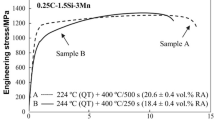A comparative study of the fracture features of a promising low-activation 12% chromium ferritic-martensitic steel EK-181 after uniaxial tensile tests in the temperature range from –196 to 800°C in the states after traditional heat treatment (THT) and high-temperature thermomechanical treatment (HTMT) is carried out. It is shown that the features of steel fracture weakly depend on the treatment mode and are determined by the temperature dependence of its yield stress. In the temperature range from –196 to 20°С, there are differences in the orientation of secondary microcracks depending on the treatment mode – after HTMT they are mainly parallel to the rolling plane, after THT their orientation is more chaotic. At Т ≥ 300°С, the differences in the type of steel fracture after the experimental treatments practically disappear. When the temperature decreases from 20 to –80°С, the fracture mechanism of steel after both treatments changes from mixed (by the mechanisms of transcrystalline dimple fracture and transcrystallite quasi-cleavage) to brittle fracture with quasi-cleavage. At the same time, some elements of brittle intercrystalline fracture are found, the fraction of which increases with the temperature decreasing from 20 to –196°С. In the region of positive temperatures from 350 to 800°С, destruction occurs by the mechanism of ductile transcrystalline dimple fracture.
Similar content being viewed by others
References
C. Cabet, F. Dalle, E. Gaganidze, J. Henry, and H. Tanigawa, J. Nucl. Mater., 523, 510 (2019).
A. G. Ioltukhovskiy, M. V. Leonteva-Smirnova, M. I. Solonin, et al., J. Nucl. Mater., 307–311, 532 (2002).
M. V. Lentieva-Smirnova, A. N. Agafonov, G. N. Ermolayev, et al., Zh. Perspekt. Mater., 6, 40 (2006).
N. A. Polekhina, I. Yu. Litovchenko, A. N. Tyumentsev, et al., Tech. Phys., 62, Iss. 5, 736 (2017).
N. A. Polekhina, K. V. Almaeva, I. Yu. Litovchenko, et al., VANT. Ser. Termoyad. Sint., 42, Iss. 4, 31 (2019).
V. M. Chernov, G. N. Ermolayev, and M. V. Lentieva-Smirnova, Tech. Phys., 55, Iss. 7, 985 (2010).
N. A. Polekhina, I. Yu. Litovchenko, A. N. Tyumentsev, et al., Physics of Atomic Nuclei, 81, Iss. 7, 1024. (2018).
J. Fellows Fractography and Atlas of Fractographs, Metals Handbook. Volume 9. American Society for Metals, Metals Park, Ohio (1974).
M. V. Odnobokova, A. Yu. Kipelova, A. N. Belyakov, and R. O. Kaibyshev, Phys. Met. Metallogr., 117, No. 4, 390 (2016).
Author information
Authors and Affiliations
Corresponding author
Additional information
Translated from Izvestiya Vysshikh Uchebnykh Zavedenii, Fizika, No. 8, pp. 82–87, August, 2021.
Rights and permissions
About this article
Cite this article
Polekhina, N.A., Litovchenko, I.Y., Almaeva, K.V. et al. Fracture Mechanisms of Low Activation 12% Chromium Ferritic-Martensitic Steel EK-181 in the Temperature Range from –196 to 800°C. Russ Phys J 64, 1468–1473 (2021). https://doi.org/10.1007/s11182-022-02520-9
Received:
Published:
Issue Date:
DOI: https://doi.org/10.1007/s11182-022-02520-9




